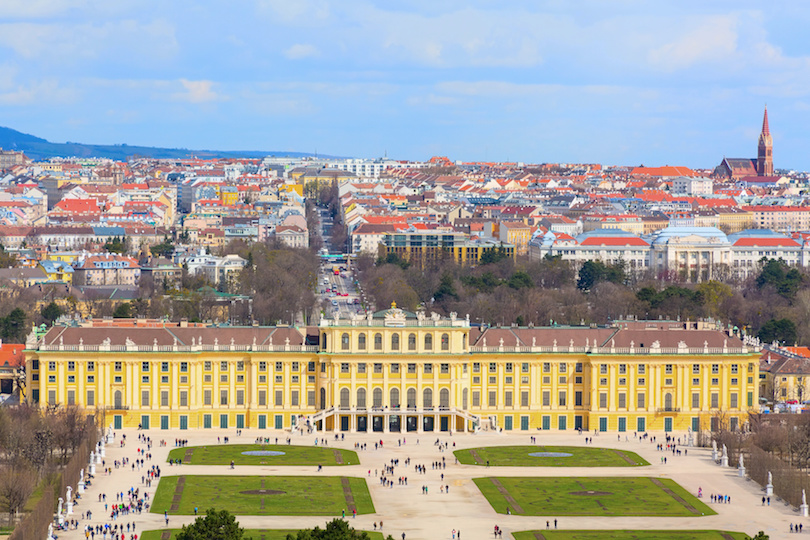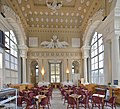
Schönbrunn Palace (German: Schloss Schönbrunn [ʃøːnˈbʁʊn]; Central Bavarian: Schloss Scheenbrunn) was the main summer residence of the Habsburg rulers, located in Hietzing, Vienna. The 1,441-room Rococopalace is one of the most important architectural, cultural, and historic monuments in the country. Since the mid-1950s it has been a major tourist attraction. The history of the palace and its vast gardens spans over 300 years, reflecting the changing tastes, interests, and aspirations of successive Habsburg monarchs.[2]
The 1,441 room Schönbrunn Palace, comparable in grandeur to Versailles, is one of the major tourist attractions in Vienna. The palace was built between 1696 and 1712 at the request of Emperor Leopold I and turned into the imperial summer palace by Maria Theresa. The Palace Park offers a lot of attractions, such as the Privy Garden, the oldest zoo in the world, a maze and labyrinth, and the Gloriette (a marble summerhouse) situated on top of a 60 meter high hill.Schönbrunn Palace was the main summer residence of the Habsburg rulers, located in Hietzing, Vienna. The 1,441-room Rococo palace is one of the most important architectural, cultural, and historic monuments in the country. Since the mid-1950s it has been a major tourist attraction.
Activities at Schönbrunn todayEdit
Schönbrunn is Vienna's most popular tourist destination, attended by 3,800,000 visitors in 2017.[7] The whole Schönbrunn complex with Tiergarten Schönbrunn, Palmenhaus, Wüstenhaus and the Wagenburg, accounted for more than five million visitors in 2009.[8] At the official website tickets can be purchased in advance for tours. In addition to tours and tour packages, many classical concerts featuring the music of Mozart and his contemporaries can be enjoyed with the added benefit of more time in the spectacular halls, Orangerie, or Schlosstheater.
The annual Summer Night Concert Schönbrunn is held on the grounds of Schönbrunn.[9]
Film and television productionsEdit
The gardens and palace have been the location for many films and television productions including such productions as the Sissi trilogy in the 1950s, A Breath of Scandalwith Sophia Loren, and also briefly in James Bond's The Living Daylights when Bond and Kara are riding through the palace garden; the palace is also seen during the end credits.[The Austrian television series, Kommissar Rexhas shot several episodes there. In the Kuroshitsuji episode 2: His Butler, Omnipotent, Sebastian Michaelis tells his master that he was a guest at the Schönbrunn Palace soirees before his contract was sealed with Ciel as he teaches the young master how to dance. Dutch violinist André Rieu and the Johann Strauss Orchestra, along with the Opera Babes used it as the back drop for a version of the European Anthem, "Ode to Joy" in 2003.
In the sixth leg of the Amazing Race 23, teams had to race through the garden's maze and search for the pit stop located at the Gloriette.
American animated television series Little Einsteins featured the Schönbrunn Palace during the episode The Glass Slipper Ball, which first aired in January 2007.
GalleryEdit

Schönbrunn main facade

Panorama of Schönbrunn from the Gloriette, with Vienna in background
Panorama of the entrance court

A garden pavilion, Kammergarten pavilion

Cafe Gloriette Schönbrunn

The Roman Ruin.

View from Great Parterre towards the Gloriette
(app. towards South).

View of the gardens

View of the gardens in autumn

Orangery, in NE part of the gardens.

Columbary

Palm pavilion in western part of the gardens

The Palm House

Sundial House

Privy garden in winter

Schönbrunn seen through Neptune Fountain

Schönbrunn
The Schönbrunn Palace silver coinEdit
The palace was selected as the main motif of a high value commemorative coin: the Austrian 10-euro The Palace of Schönbrunn silver coin, minted on October 8, 2003. The obverse shows the central part of the frontage of the palace behind one of the great fountains in the open space.
Comments
Post a Comment